A Decade-Long Assessment of Water Quality Variability in the Yelek River Basin (Kazakhstan) Using Remote Sensing and GIS
Abstract
1. Introduction
2. Materials and Methods
2.1. Study Area
2.2. Methods
2.2.1. Data Sources and Study Period
2.2.2. Field Work and Sampling
2.2.3. Satellite Monitoring and Satellite Image Processing
2.2.4. Integral Assessment of Water Quality
3. Results
- Water turbidity values in NTU units obtained from field measurements,
- NDTI values calculated from satellite images (remote sensing data).
4. Discussion
5. Conclusions
Author Contributions
Funding
Institutional Review Board Statement
Informed Consent Statement
Data Availability Statement
Conflicts of Interest
Abbreviations
| RS | Remote sensing |
| GIS | Geographic information systems |
| TSS | Total suspended solids |
| TDS | Total dissolved solids |
| DO | Dissolved oxygen |
| NDWI | Normalised Difference Water Index |
| NDTI | Normalised Difference Turbidity Index |
| SS | State Standard |
| OLI | Operational Land Imager |
| ETM | Enhanced Thematic Mapper |
| TM | Thematic Mapper |
| GEE | Google Earth Engine |
| DOS | Dark Object Subtraction |
| DEM | Digital elevation model |
| FNU | Formazin Nephelometric Units |
| UTM | Universal Transverse Mercator |
| WPI | Water pollution index |
| CWPI | Comprehensive water pollution index |
| MPC | Maximum permissible concentration |
| WKR | West Kazakhstan Region |
| JJASON | June, July, August, September, October, November |
| DJFM | December, January, February, March |
| AM | April–May |
| MRHE | Maximum Permissible Harmful Emission |
References
- Clark, E.A.; Sheffield, J.; van Vliet, M.T.H.; Nijssen, B.; Lettenmaier, D.P. Continental runoff into the oceans (1950–2008). J. Hydrometeorol. 2015, 16, 1502–1520. [Google Scholar] [CrossRef]
- Jadeja, N.B.; Banerji, T.; Kapley, A.; Kumar, R. Water pollution in India–Current scenario. Water Secur. 2022, 16, 100119. [Google Scholar] [CrossRef]
- Kirschner, A.K.T.; Schachner-Groehs, I.; Kavka, G.; Hoedl, E.; Kovacs, A.; Farnleitner, A.H. Long-term impact of basin-wide wastewater management on faecal pollution levels along the entire Danube River. Environ. Sci. Pollut. Res. 2024, 31, 45697–45710. [Google Scholar] [CrossRef]
- Addo-Bediako, A.; Matita, T.; Luus-Powell, W. Flow regime impacts on chemical pollution in the water and sediments of the Moopetsi River and human health risk in South Africa. Water 2025, 17, 2200. [Google Scholar] [CrossRef]
- Carneiro, D.D.; Mariotto, S.; Sousa, D.A.; Bragotto, A.P.A. Presence of pesticide residues in water resources and fish in Brazil: Narrative bibliographic review. ACS Food Sci. Technol. 2025, 5, 1785–1797. [Google Scholar] [CrossRef]
- Adyasari, D.; Pratama, M.A.; Teguh, N.A.; Sabdaningsih, A.; Kusumaningtyas, M.A.; Dimova, N. Anthropogenic impact on Indonesian coastal water and ecosystems: Current status and future opportunities. Mar. Pollut. Bull. 2021, 171, 112689. [Google Scholar] [CrossRef]
- Zlati, M.L.; Georgescu, L.P.; Iticescu, C.; Ionescu, R.V.; Antohi, V.M. New approach to modelling the impact of heavy metals on the European Union’s water resources. Int. J. Environ. Res. Public Health 2023, 20, 45. [Google Scholar] [CrossRef] [PubMed]
- Jarvie, H.P.; Worrall, F.; Burt, T.P.; Howden, N.J.K. A 150-year river water quality record shows reductions in phosphorus loads but not in algal growth potential. Commun. Earth Environ. 2025, 6, 62. [Google Scholar] [CrossRef]
- Burlibaev, M.Z. Assessment of surface water quality by hydrochemical indicators on the example of the Ile River. Hydrometeorol. Ecol. 2009, 1, 94–101. [Google Scholar]
- Amirgaliev, N.; Madibekov, A.; Ismukhanova, L.; Zhadi, A.; Sultanbekova, B. Polychlorinated biphenyls in the aquatic ecosystem of the protected Lake Markakol and its inflowing rivers. Hydrometeorol. Ecol. 2024, 2, 81–94. [Google Scholar] [CrossRef]
- Dostai, Z.; Romanova, S.; Kunshygar, D. Hydroecological characteristics of rivers of the northern slope of the Zailiysky Alatau. Hydrometeorol. Ecol. 2004, 1, 144–155. [Google Scholar]
- Popov, Y.; Pavlichenko, L.; Bogachev, V. Study of Syrdarya River pollution for the development of an integrated water quality assessment. Hydrometeorol. Ecol. 1996, 2, 207–223. [Google Scholar]
- Amirgaliev, N.A.; Askarova, M.; Opp, C.; Medeu, A.; Kulbekova, R.; Medeu, A.R. Water quality problems analysis and assessment of the ecological security level of the transboundary Ural-Caspian Basin of the Republic of Kazakhstan. Appl. Sci. 2022, 12, 2059. [Google Scholar] [CrossRef]
- Severinenko, M.; Solodukhin, V.; Lennik, S.; Kabirova, G.; Zheltov, D.; Bychenko, A. Water elemental composition and toxicity in Kazakhstan’s transboundary rivers. Central Asian J. Water Res. 2023, 9, 19–32. [Google Scholar] [CrossRef]
- Tazhiyev, S.; Murtazin, Y.; Rakhimova, V.; Rakhmetov, I.; Adenova, D.; Koshpanova, K.; Sotnikov, Y.; Abdizhalel, M.; Akylbayeva, A.; Yerezhep, D. Applied hydrogeological assessment and GIS-based modeling of transboundary aquifers in the Shu River Basin. Water 2025, 17, 2476. [Google Scholar] [CrossRef]
- Kakabayev, A.; Yessenzholov, B.; Khussainov, A.; Rodrigo-Ilarri, J.; Rodrigo-Clavero, M.-E.; Kyzdarbekova, G.; Dankina, G. The impact of climate change on the water systems of the Yesil River Basin in Northern Kazakhstan. Sustainability 2023, 15, 15745. [Google Scholar] [CrossRef]
- Yessenzholov, B.; Khussainov, A.; Kakabayev, A.; Plachinta, I.; Bayazitova, Z.; Kyzdarbekova, G.; Zhamkenov, U.; Ramazanova, M. Assessment of hydrometeorological impacts of climate change on water bodies in Northern Kazakhstan. Water 2024, 16, 2794. [Google Scholar] [CrossRef]
- KC, A.; Chalise, A.; Parajuli, D.; Dhital, N.; Shrestha, S.; Kandel, T. Surface water quality assessment using remote sensing, GIS and artificial intelligence. Technol. J. 2019, 1, 113–122. [Google Scholar] [CrossRef]
- Yang, H.; Kong, J.; Hu, H.; Du, Y.; Gao, M.; Chen, F. A review of remote sensing for water quality retrieval: Progress and challenges. Remote Sens. 2022, 14, 1770. [Google Scholar] [CrossRef]
- Ahmed, W.; Mohammed, S.; El-Shazly, A.; Morsy, S. Tigris River water surface quality monitoring using remote sensing data and GIS techniques. Egypt. J. Remote Sens. Space Sci. 2023, 26, 816–825. [Google Scholar] [CrossRef]
- Hafeez, S.; Wong, M.S.; Abbas, S.; Asim, M. Evaluating Landsat-8 and Sentinel-2 data consistency for high spatiotemporal inland and coastal water quality monitoring. Remote Sens. 2022, 14, 3155. [Google Scholar] [CrossRef]
- Ouma, Y.O.; Tateishi, R. Modelling reservoir chlorophyll-a, TSS, and turbidity using Sentinel-2A MSI and Landsat-8 OLI satellite sensors with empirical multivariate regression. Sensors 2020, 20, 885. [Google Scholar] [CrossRef]
- Dzhanaleyeva, G.M. Rivers of the Aktobe region and their hydrological characteristics. Bull. KazNPU Geogr. Ser. 2010, 3, 45–52. [Google Scholar]
- Berdenov, Z.G.; Zinabdin, N.B.; Yeginbayeva, A.E.; Mendybaeva, G.E.; Sadvakassova, S.R.; Kakimzhanov, E.K. Analysis and assessment of surface water quality in the Yelek River basin under technogenic impact. Hydrometeorol. Ecol. 2024, 4, 15–27. [Google Scholar] [CrossRef]
- Editor-in-chief Ayagan, B. Kazakhstan. National Encyclopedia; Kazakh Encyclopedia: Almaty, Kazakhstan, 2006. [Google Scholar]
- Akhmedsafin, M.S. Hydrology of Kazakhstan; Nauka: Alma-Ata, Kazakhstan, 1975. [Google Scholar]
- Slyusarev, S.G. Hydrological Regime of Steppe Rivers of Kazakhstan; KarGU Publishing: Karaganda, Kazakhstan, 2006. [Google Scholar]
- Yesirkepov, D.Z. Hydrological features of the Yelek River basin. In Proceedings of the International Conference “Water and Sustainable Development”, Almaty, Kazakhstan, 8 November 2022; pp. 101–106. [Google Scholar]
- Sapozhnikov, D.G. Ice phenomena on the rivers of Western Kazakhstan. Geogr. Nat. Resour. 2018, 4, 62–69. [Google Scholar]
- Nurtaeva, A.K.; Abylgazy, N.K. Assessment of changes in river flow in the Aktobe region under climate conditions. Kazakh, J. Ecol. 2019, 2, 18–24. [Google Scholar]
- Smagulov, E.Z.; Temirbekova, G.T. Anthropogenic impact on the water resources of the Yelek River. Geogr. Ecol. Kazakhst. 2021, 1, 74–81. [Google Scholar]
- Galperin, R.I. (Ed.) River Runoff Resources of Kazakhstan: Vol. 1. Renewable Surface Water Resources of Western, Northern, Central, and Eastern Kazakhstan; Geography Institute: Almaty, Kazakhstan, 2012; 684p. [Google Scholar]
- Dostai, Z.D.; Romanova, S.M.; Tursunov, E.A. River Runoff Resources of Kazakhstan: Vol. 3. Surface Water Quality of Kazakhstan and Issues of International Water Division; Geography Institute: Almaty, Kazakhstan, 2012; 215p. [Google Scholar]
- Zhanabayeva, Z.A.; Musina, A.K.; Aktymbayeva, A.A.; Rysmagambetova, A.A.; Narbayeva, K.T.; Sarybayev, E.S.; Akhmetova, R.E. The current state of water quality in the Zhaiyk-Caspian basin in Kazakhstan. Geogr. Water Resour. 2024, 4, 67–74. [Google Scholar] [CrossRef]
- McFeeters, S.K. The use of the normalized difference water index (NDWI) in the delineation of open water features. Int. J. Remote Sens. 1996, 17, 1425–1432. [Google Scholar] [CrossRef]
- Burlibaev, M.; Dzhumagulov, A.; Burlibaeva, D. On the transition to the European classification of river water quality and the methodology for determining their ecological state. Hydrometeorol. Ecol. 2008, 2–3, 143–151. [Google Scholar]
- Burlibaev, M.; Istomina, O.; Popov, Y. On the issue of determining the water pollution index. Hydrometeorol. Ecol. 1997, 4, 126–132. [Google Scholar]
- Burlibaev, M.Z.; Pavlichenko, L.M.; Shesterneva, O.G. Towards a concept of integrated assessment of surface water quality. Hydrometeorol. Ecol. 1998, 3–4, 86–112. [Google Scholar]
- Burlibaeva, D.M.; Burlibaev, M.Z.; Ryskeldieva, A.M.; Kaidarova, R.K.; Opp, C.; Amirgaliev, N.A. Dynamics of concentration changes of heavy metal group pollutants in surface water of the transboundary Ertis River on the territory of the Republic of Kazakhstan. Bull. Geogr. 2020, 2, 54–68. [Google Scholar]
- Burlibaev, M.Z.; Burlibaeva, D.M. Quality of surface waters and principles of ecological regulation. Hydrometeorol. Ecol. J. 2011, 1, 119–140. [Google Scholar]
- National Methodology for Assessing Surface Water Quality of the Republic of Kazakhstan (Order No. 111, 2025). Available online: https://adilet.zan.kz/rus/docs/G25MA000111 (accessed on 15 October 2025).
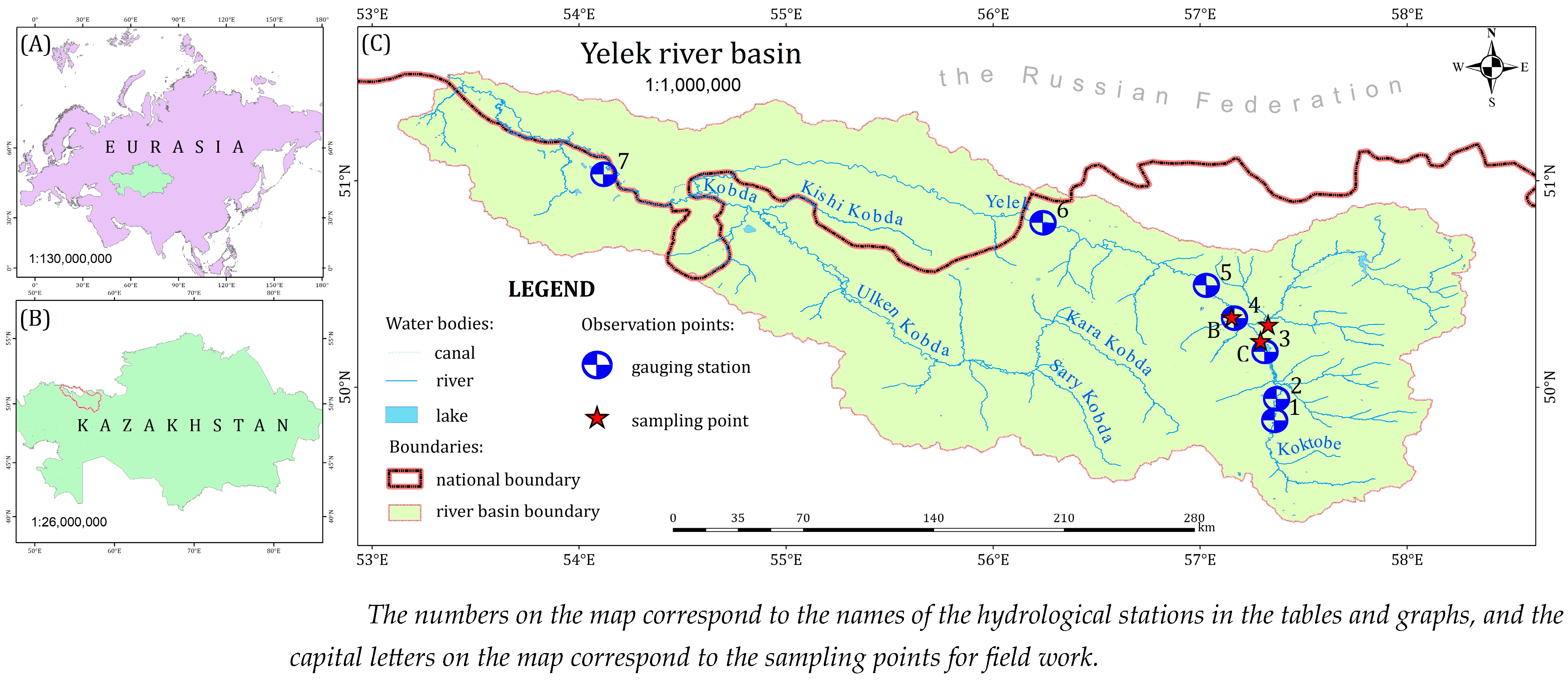
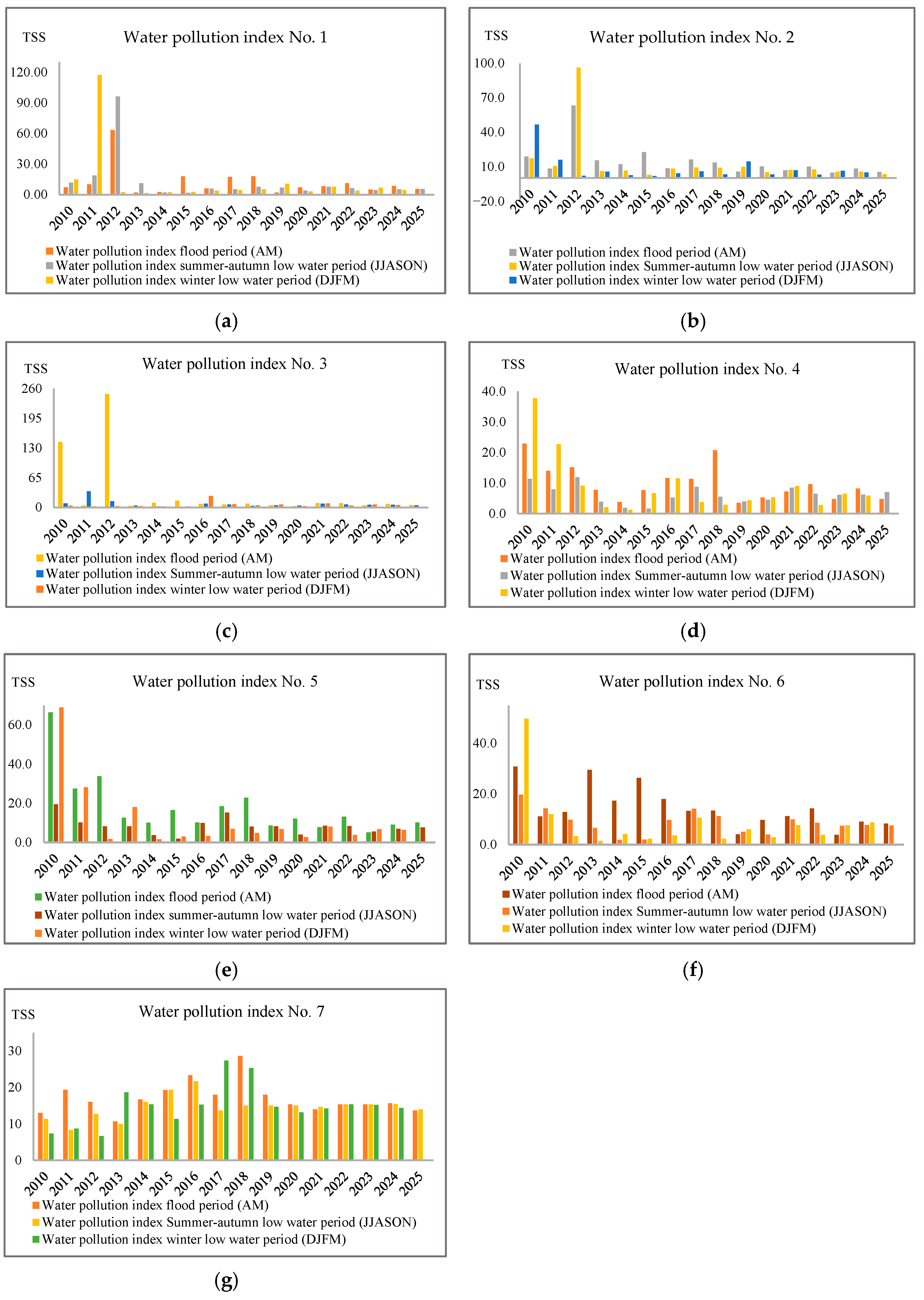

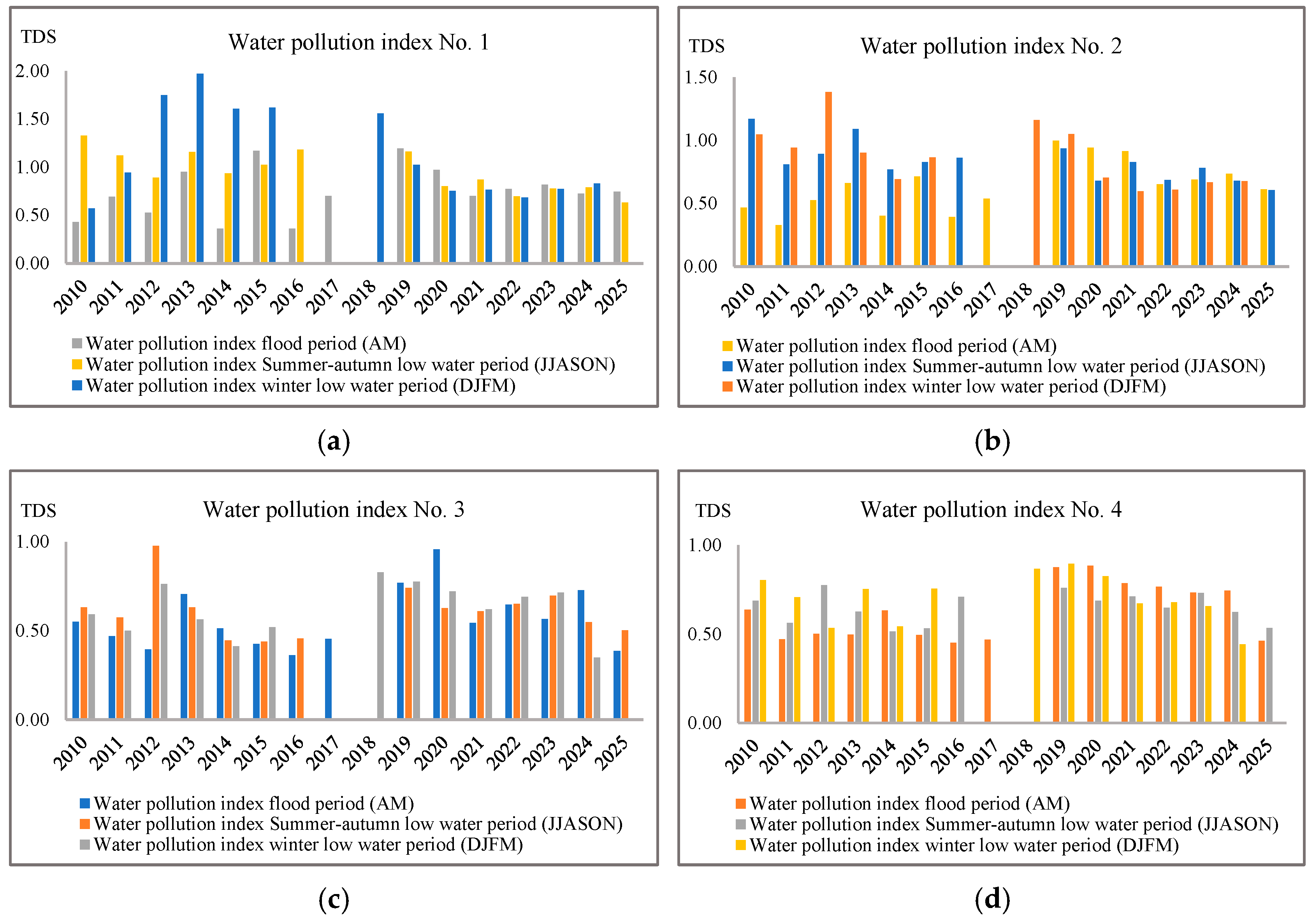
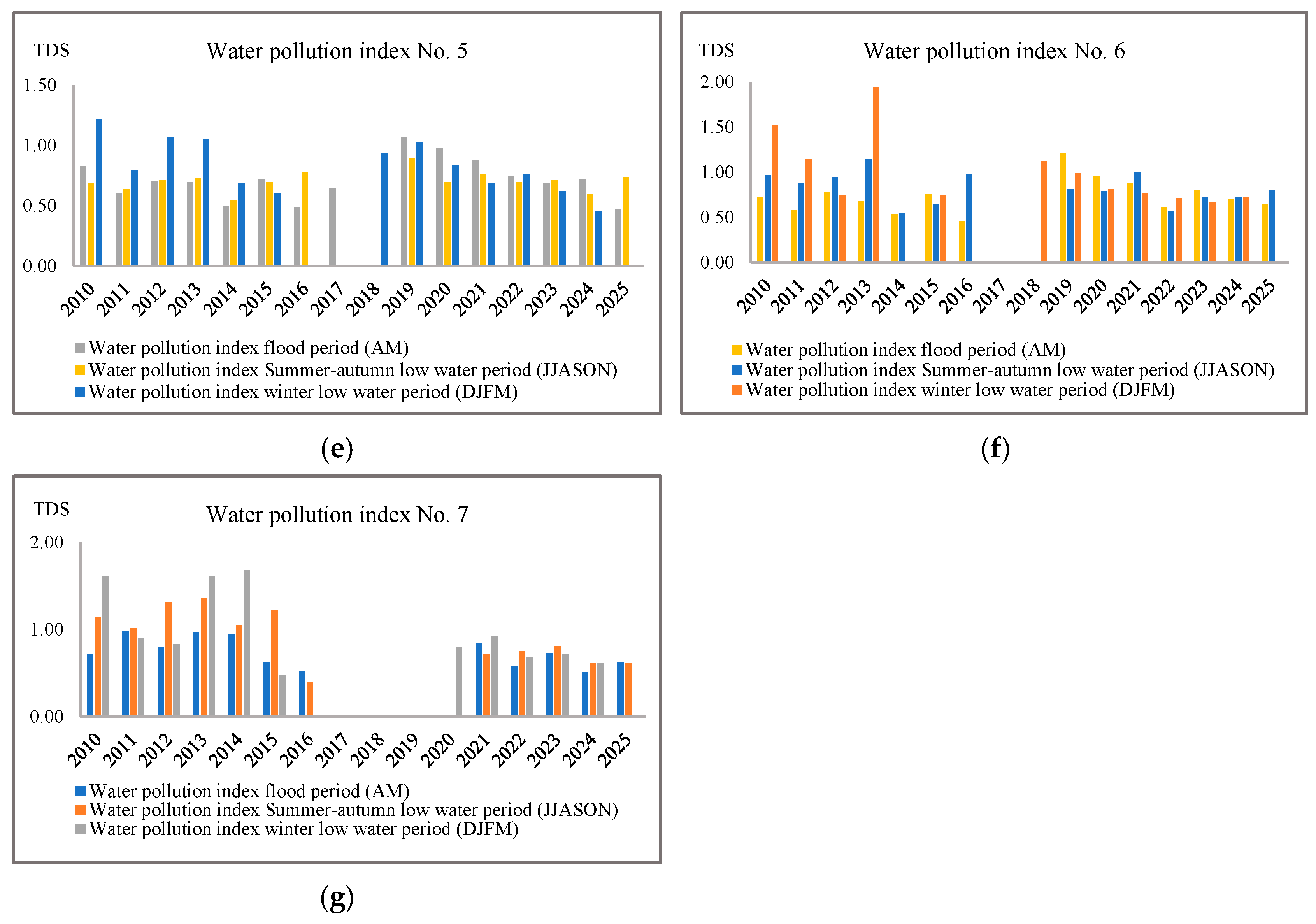
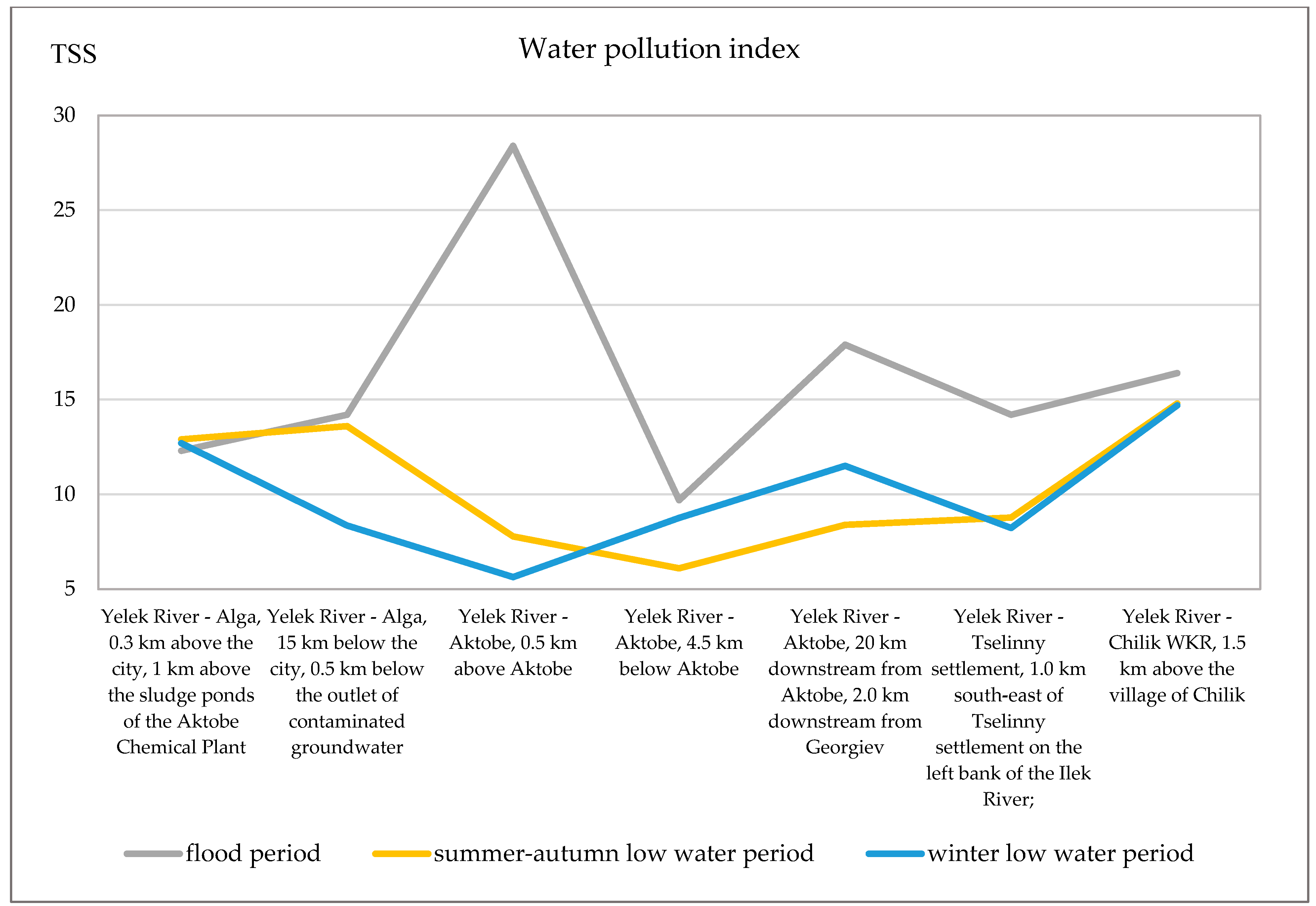
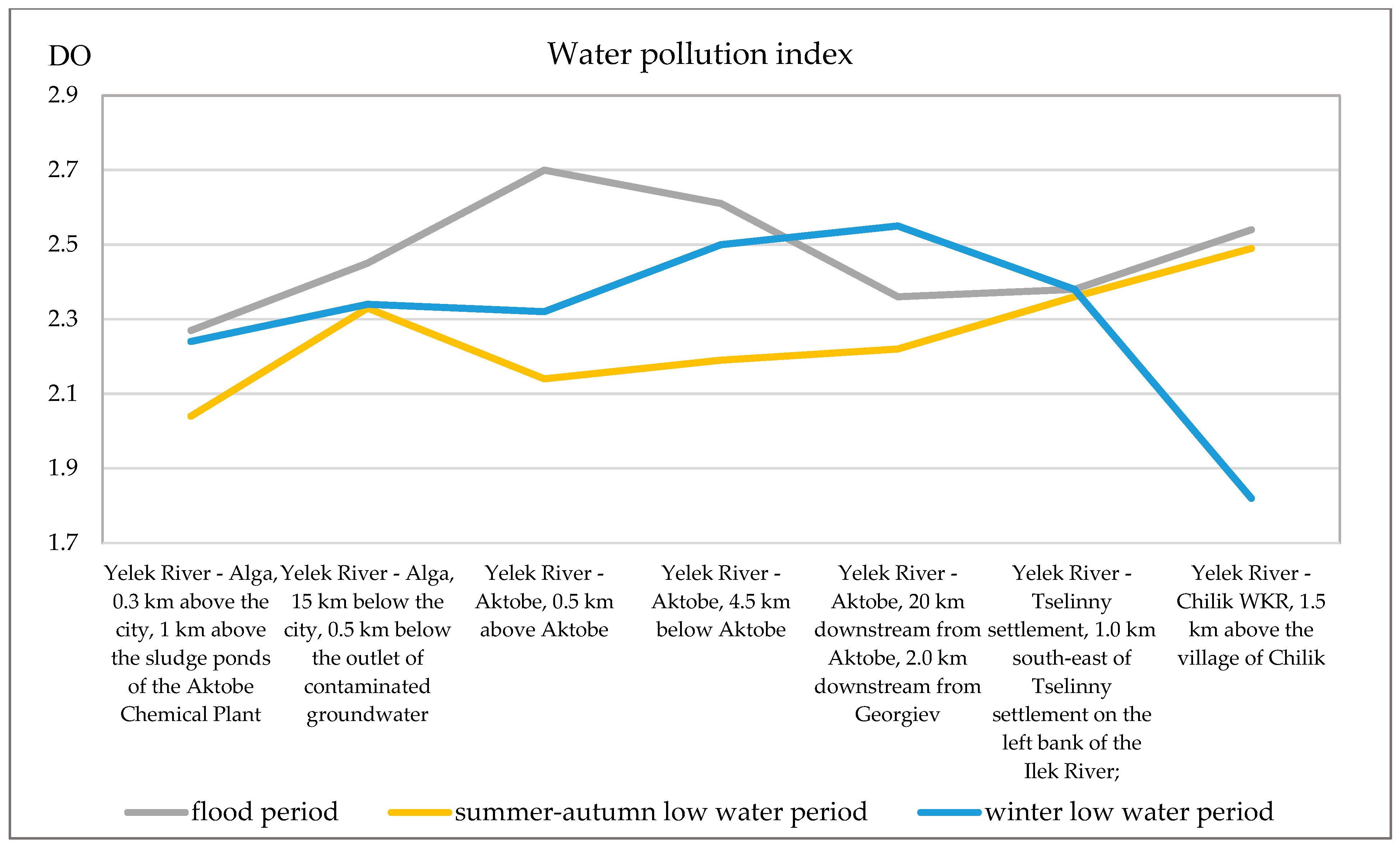
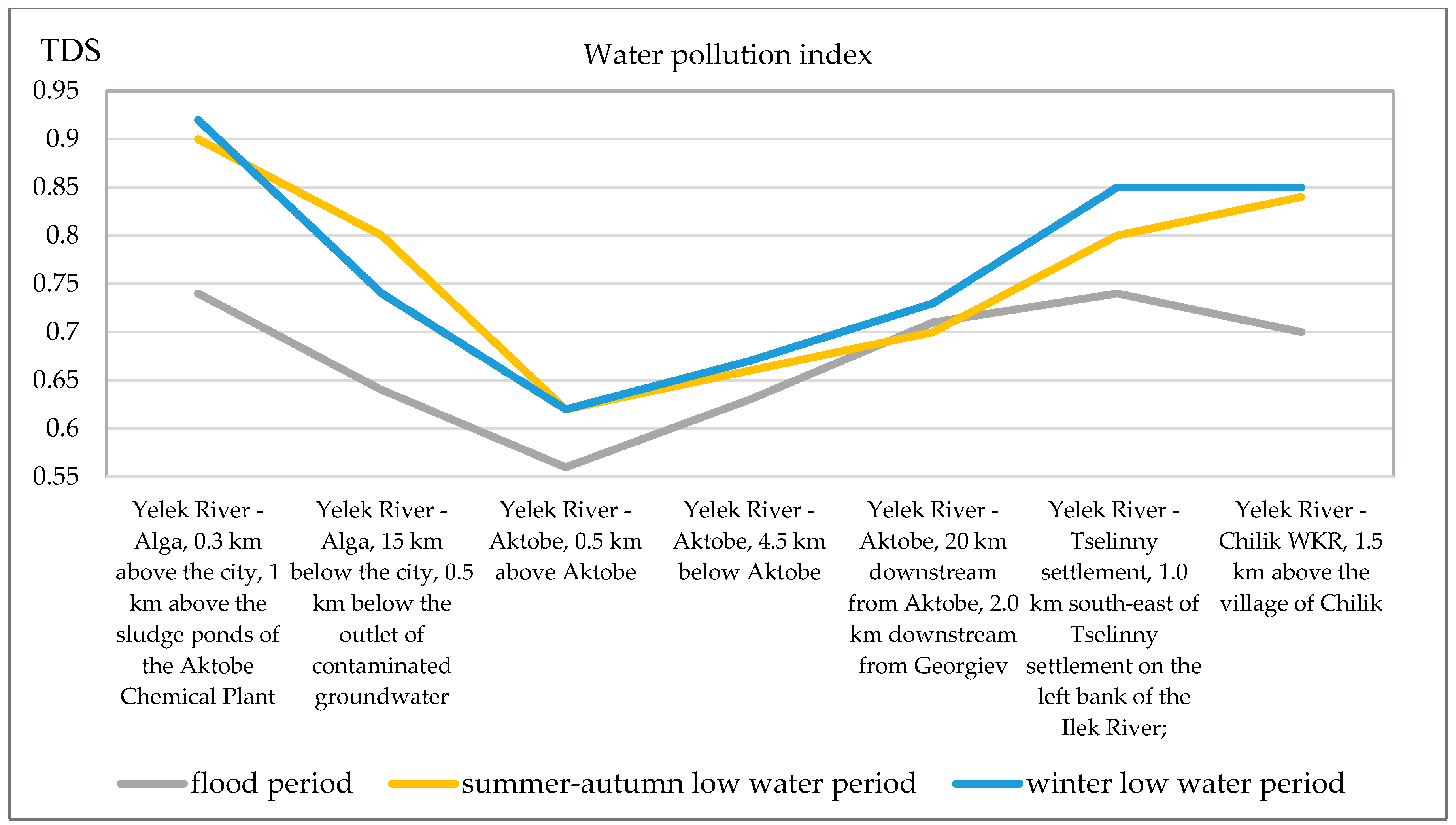

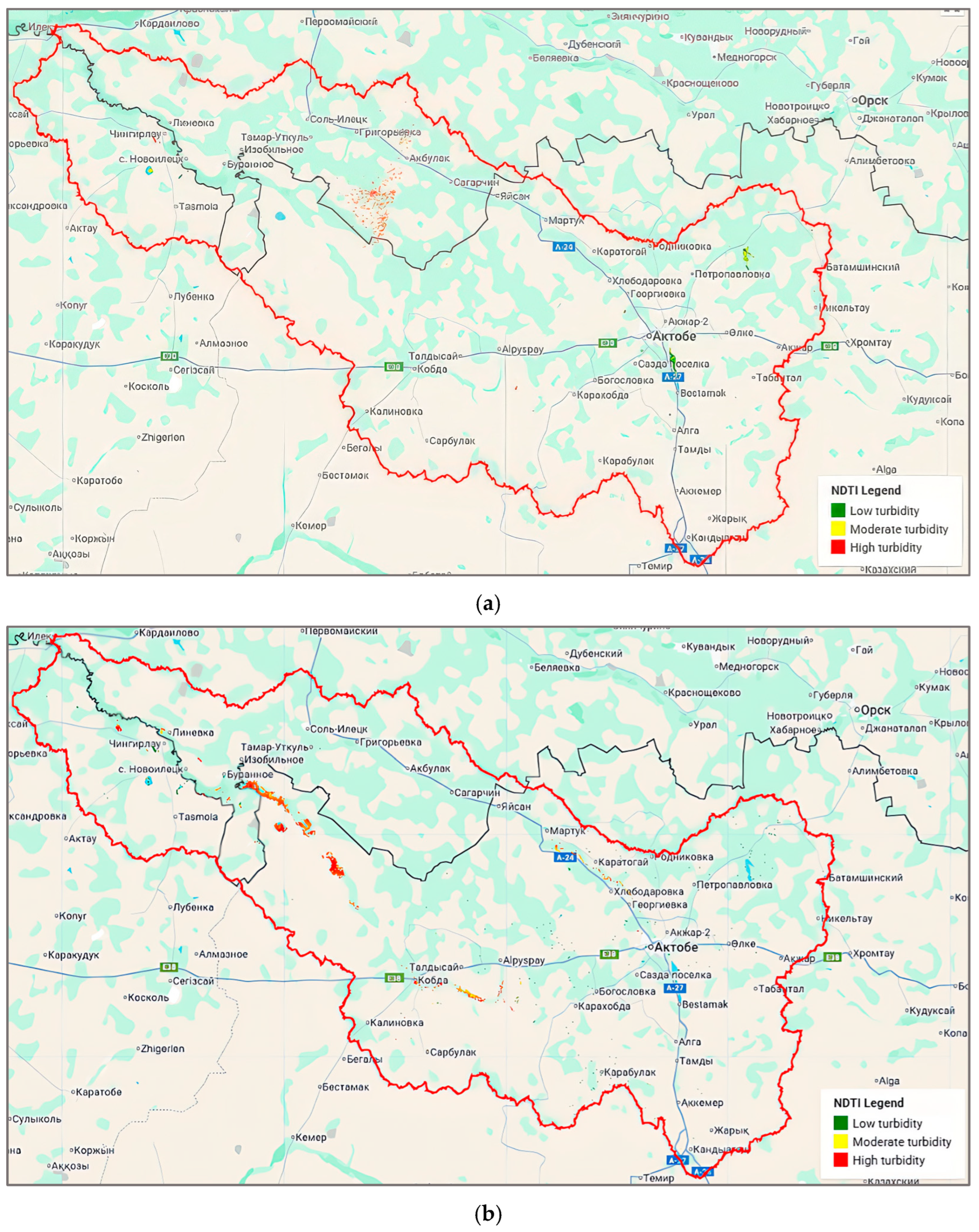



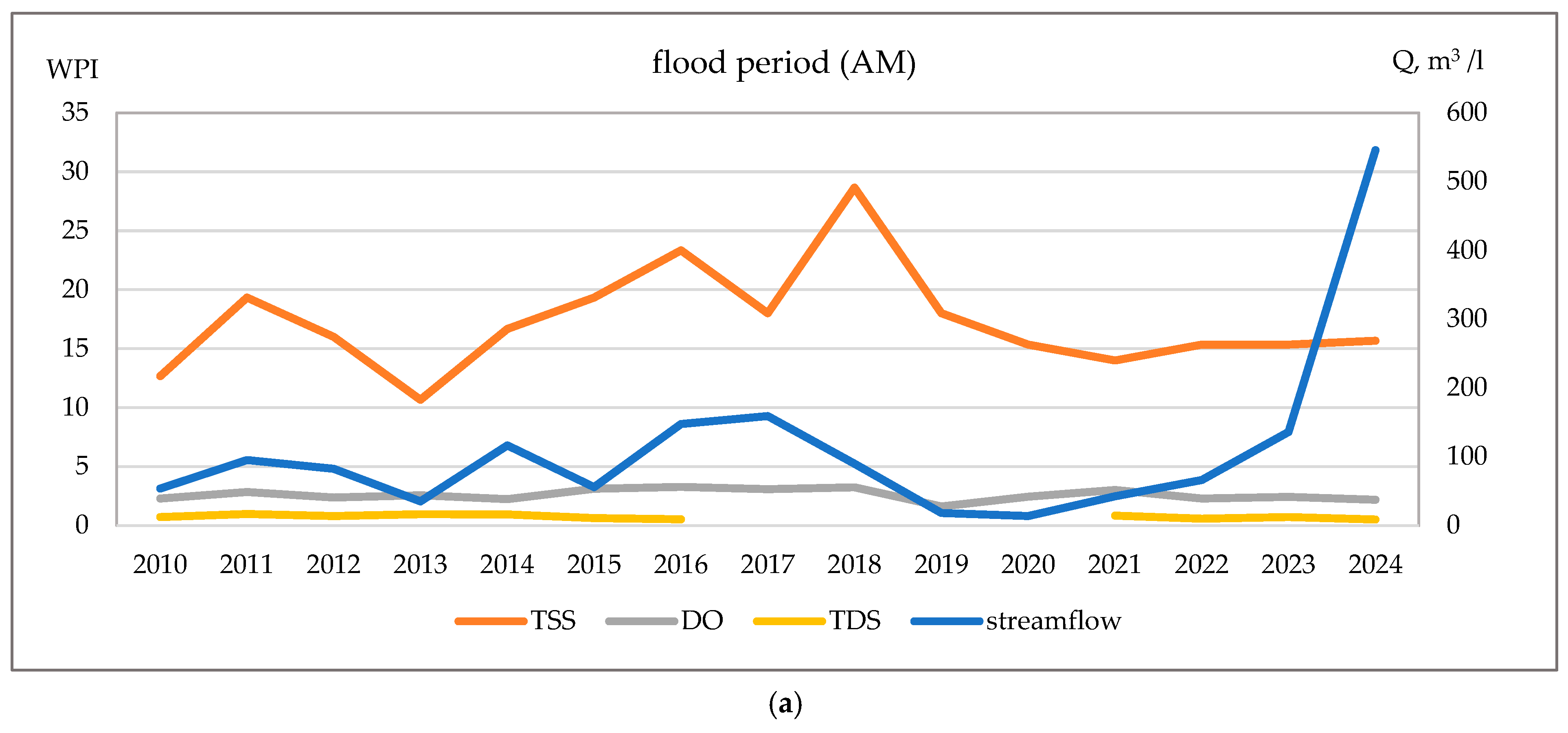


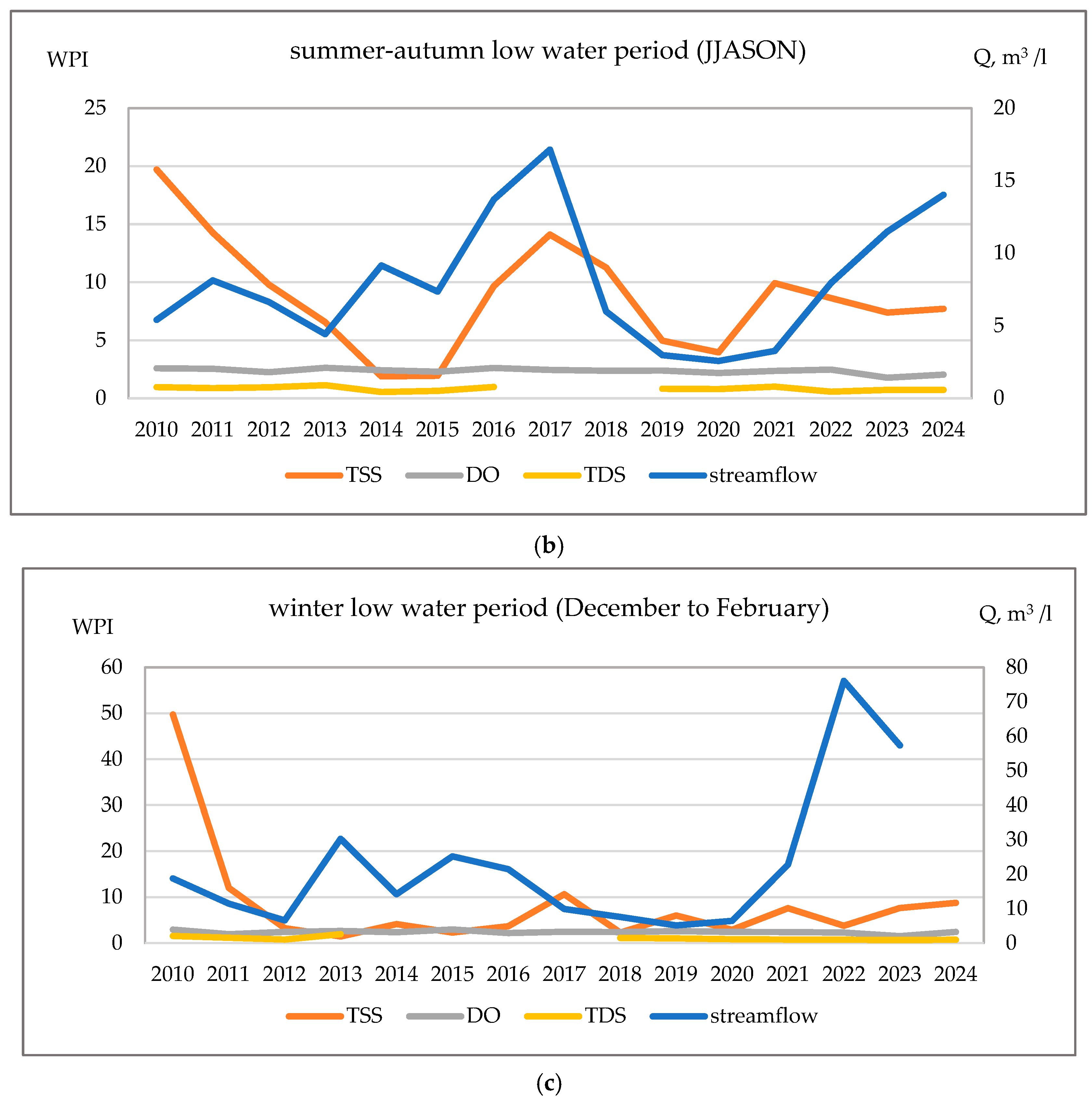
| Sampling Point | Coordinate Values | Duration of Field Work | Hydrological Periods | |
|---|---|---|---|---|
| x | y | |||
| A | 50°18′15″ N | 57°19′41″ E | 30 May 2024–2 July 2024 | flood period (AM) |
| 27 September 2024–5 November 2024 | summer-autumn low water period (JJASON) | |||
| 28 April 2025–30 May 2025 | flood period (AM) | |||
| B | 50°20′25″ N | 57°09′11″ E | 30 May 2024–2 July 2024 | flood period (AM) |
| 27 September 2024–5 November 2024 | summer-autumn low water period (JJASON) | |||
| 28 April 2025–30 May 2025 | flood period (AM) | |||
| C | 50°13′31″ N | 57°17′32″ E | 30 May 2024–2 July 2024 | flood period (AM) |
| 27 September 2024–5 November 2024 | summer-autumn low water period (JJASON) | |||
| 28 April 2025–30 May 2025 | flood period (AM) | |||
| Year | Flood Period (AM) | Summer-Autumn Low Water Period (JJASON) | Winter Low Water Period (DJFM) |
|---|---|---|---|
| 2014 | 0.09 | 0.05 | 0.25 |
| 2015 | 0.02 | 0.05 | 0.25 |
| 2016 | 0.02 | 0.05 | 0.25 |
| 2017 | 0.02 | 0.05 | 0.25 |
| 2018 | 0.09 | 0.10 | 0.20 |
| 2019 | 0.02 | 0.05 | 0.25 |
| 2020 | 0.02 | 0.10 | 0.40 |
| 2021 | 0.02 | 0.25 | 0.20 |
| 2022 | 0.02 | 0.05 | 0.40 |
| 2023 | 0.02 | 0.05 | 0.30 |
| 2024 | 0.05 | 0.08 | 0.40 |
| Water Quality Class | Description | WPI Range |
|---|---|---|
| I | Very clean | ≤0.2 |
| II | Clean | 0.21–1.0 |
| III | Moderately polluted | 1.01–2.0 |
| IV | Polluted | 2.01–4.0 |
| V | Very polluted | 4.01–6.0 |
| VI | Extremely polluted | 6.01–10.0 |
| No | Gauging Station | Coordinate Values | Water Pollution Index (for Last Decade) | ||||||
|---|---|---|---|---|---|---|---|---|---|
| X | Y | Flood Period (AM) | Water Quality Categories | Summer-Autumn Low Water Period (JJASON) | Water Quality Categories | Winter Low Water Period (DJFM) | Water Quality Categories | ||
| 1 | Yelek River—Aktobe, 0.5 km upstream from Aktobe | 50°10′ N | 57°11′ E | 28.4 | Extremely polluted | 7.78 | Very polluted | 5.6 | Polluted |
| 2 | Yelek River—Aktobe, 4.5 km downstream from Aktobe | 50°20′ N | 57°10′ E | 9.69 | Very polluted | 6.1 | Polluted | 8.75 | Very polluted |
| 3 | Yelek River—Aktobe, 20 km below Aktobe, 2.0 km below Georgievka | 50°20′ N | 57°00′ E | 17.9 | Extremely polluted | 8.39 | Very polluted | 11 | Extremely polluted |
| 4 | Yelek River—Alga, 0.3 km above the city, 1 km above the sludge ponds of the Aktobe Chemical Plant | 49°50′ N | 57°20′ E | 12. | Extremely polluted | 12.9 | Extremely polluted | 12.7 | Extremely polluted |
| 5 | Yelek River—Alga, 15 km downstream from the city, 0.5 km downstream from the outlet of contaminated groundwater | 49°50′ N | 57°21′ E | 14. | Extremely polluted | 13. | Extremely polluted | 8.35 | Very polluted |
| 6 | Yelek River—Tselinny, 1.0 km southeast of Tselinny on the left bank of the Ilek River | 50°47′ N | 56°14′ E | 14.2 | Extremely polluted | 8.77 | Very polluted | 8.2 | Very polluted |
| 7 | Yelek River—Chilik settlement, West Kazakhstan Region, 1.5 km above the village of Chilik | 51°00′ N | 54°00′ E | 16. | Extremely polluted | 14. | Extremely polluted | 14.7 | Extremely polluted |
| No | Gauging Station | Coordinate Values | Water Pollution Index (for Last Decade) | ||||||
|---|---|---|---|---|---|---|---|---|---|
| X | Y | Flood Period (AM) | Water Quality Categories | Summer-Autumn Low Water Period (JJASON) | Water Quality Categories | Winter Low Water Period (DJFM) | Water Quality Categories | ||
| 1 | Yelek River—Aktobe, 0.5 km upstream from Aktobe | 50°10′ N | 57°11′ E | 2.7 | Polluted | 2.1 | Moderately polluted | 2.32 | Moderately polluted |
| 2 | Yelek River—Aktobe, 4.5 km downstream from Aktobe | 50°20′ N | 57°10′ E | 2.61 | Polluted | 2.19 | Moderately polluted | 2.5 | Polluted |
| 3 | Yelek River—Aktobe, 20 km downstream from Aktobe, 2.0 km downstream from Georgiev village | 50°20′ N | 57°00′ E | 2.36 | Moderately polluted | 2.22 | Moderately polluted | 2.55 | Polluted |
| 4 | Yelek River—Alga, 0.3 km above the city, 1 km above the sludge ponds of the Aktobe Chemical Plant | 49°50′ N | 57°20′ E | 2.27 | Moderately polluted | 2.04 | Moderately polluted | 2.24 | Moderately polluted |
| 5 | Yelek River—Alga, 15 km downstream from the city, 0.5 km downstream from the outlet of polluted groundwater | 49°50′ N | 57°21′ E | 2.45 | Moderately polluted | 2.3 | Moderately polluted | 2.34 | Moderately polluted |
| 6 | Yelek River—Tselinny, 1.0 km southeast of Tselinny on the left bank of the Ilek River | 50°47′ N | 56°14′ E | 2.38 | Moderately polluted | 2.3 | Moderately polluted | 2.38 | Moderately polluted |
| 7 | Yelek River—Chilik settlement, West Kazakhstan Region, 1.5 km above the village of Chilik | 51°00′ N | 54°00′ E | 2.54 | Polluted | 2.49 | Moderately polluted | 1.82 | Moderately polluted |
| No | Gauging Station | Coordinate Values | Water Pollution Index (for Last Decade) | ||||||
|---|---|---|---|---|---|---|---|---|---|
| X | Y | Flood Period (AM) | Water Quality Categories | Summer-Autumn Low Water Period (JJASON) | Water Quality Categories | Winter Low Water Period (DJFM) | Water Quality Categories | ||
| 1 | Yelek River—Aktobe, 0.5 km above Aktobe | 50°10′ N | 57°11′ E | 0.56 | Clean | 0.6 | Clean | 0.62 | Clean |
| 2 | Yelek River—Aktobe, 4.5 km downstream from Aktobe | 50°20′ N | 57°10′ E | 0.6 | Clean | 0.66 | Clean | 0.67 | Clean |
| 3 | Yelek River—Aktobe, 20 km downstream from Aktobe, 2.0 km downstream from Georgiev | 50°20′ N | 57°00′ E | 0.71 | Clean | 0.7 | Clean | 0.73 | Clean |
| 4 | Yelek River—Alga, 0.3 km above the city, 1 km above the sludge ponds of the Aktobe Chemical Plant | 49°50′ N | 57°20′ E | 0.74 | Clean | 0.9 | Clean | 0.92 | Clean |
| 5 | Yelek River—Alga, 15 km downstream from the city, 0.5 km downstream from the outlet of contaminated groundwater | 49°50′ N | 57°21′ E | 0.64 | Clean | 0.8 | Clean | 0.74 | Clean |
| 6 | Yelek River—Tselinny, 1.0 km southeast of Tselinny on the left bank of the Ilek River | 50°47′ N | 56°14′ E | 0.7 | Clean | 0.8 | Clean | 0.85 | Clean |
| 7 | Yelek River—Chilik settlement, West Kazakhstan Region, 1.5 km above the village of Chilik | 51°00′ N | 54°00′ E | 0.7 | Clean | 0.84 | Clean | 0.85 | Clean |
Disclaimer/Publisher’s Note: The statements, opinions and data contained in all publications are solely those of the individual author(s) and contributor(s) and not of MDPI and/or the editor(s). MDPI and/or the editor(s) disclaim responsibility for any injury to people or property resulting from any ideas, methods, instructions or products referred to in the content. |
© 2025 by the authors. Licensee MDPI, Basel, Switzerland. This article is an open access article distributed under the terms and conditions of the Creative Commons Attribution (CC BY) license (https://creativecommons.org/licenses/by/4.0/).
Share and Cite
Mussina, A.; Aktymbayeva, A.; Zhanabayeva, Z.; Mashtayeva, S.; Macklin, M.G.; Rysmagambetova, A.; Akhmetova, R.; Alimbay, A. A Decade-Long Assessment of Water Quality Variability in the Yelek River Basin (Kazakhstan) Using Remote Sensing and GIS. Sustainability 2025, 17, 9809. https://doi.org/10.3390/su17219809
Mussina A, Aktymbayeva A, Zhanabayeva Z, Mashtayeva S, Macklin MG, Rysmagambetova A, Akhmetova R, Alimbay A. A Decade-Long Assessment of Water Quality Variability in the Yelek River Basin (Kazakhstan) Using Remote Sensing and GIS. Sustainability. 2025; 17(21):9809. https://doi.org/10.3390/su17219809
Chicago/Turabian StyleMussina, Ainur, Aliya Aktymbayeva, Zhanara Zhanabayeva, Shamshagul Mashtayeva, Mark G. Macklin, Aina Rysmagambetova, Raibanu Akhmetova, and Almas Alimbay. 2025. "A Decade-Long Assessment of Water Quality Variability in the Yelek River Basin (Kazakhstan) Using Remote Sensing and GIS" Sustainability 17, no. 21: 9809. https://doi.org/10.3390/su17219809
APA StyleMussina, A., Aktymbayeva, A., Zhanabayeva, Z., Mashtayeva, S., Macklin, M. G., Rysmagambetova, A., Akhmetova, R., & Alimbay, A. (2025). A Decade-Long Assessment of Water Quality Variability in the Yelek River Basin (Kazakhstan) Using Remote Sensing and GIS. Sustainability, 17(21), 9809. https://doi.org/10.3390/su17219809






